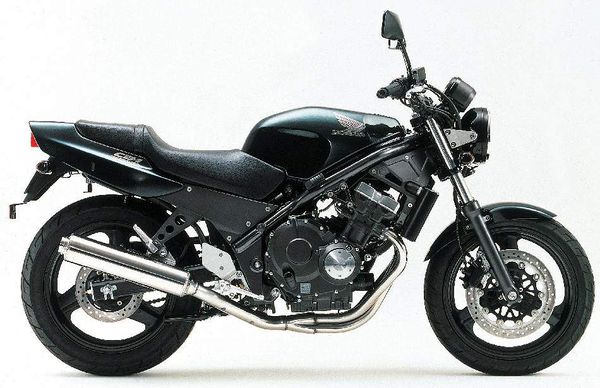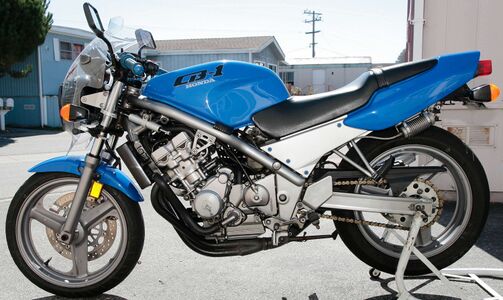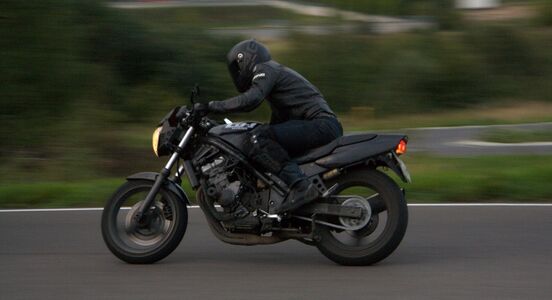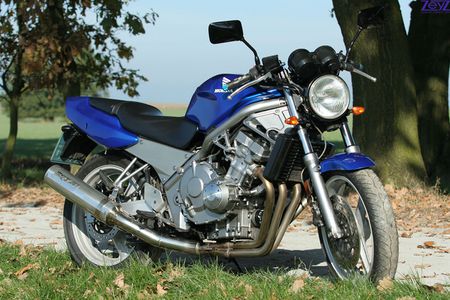Difference between revisions of "Honda CB-1"
m |
m (→Photos) |
||
| (11 intermediate revisions by the same user not shown) | |||
| Line 1: | Line 1: | ||
| − | {{DISPLAYTITLE:Honda CB-1}} | + | {{DISPLAYTITLE: Honda CB-1}} |
| − | |||
{{#seo: | {{#seo: | ||
| − | |keywords= | + | |keywords={{PAGENAME}}, review, specs, owners manual, service manual, guide |
| + | |og:image=https://en.enduro.team/images/4/45/Honda_CB-1_90.jpg | ||
}} | }} | ||
__notoc__ | __notoc__ | ||
| − | + | [[file: Honda CB-1 90.jpg | 600px | center | Honda CB-1]] | |
| − | + | The model of the legendary road motorcycle "Honda CB-1" begins its history in 1989 and is produced until 1991 (the last official sales of the motorcycle ended in 1992). | |
| − | + | {{Ads_top}} | |
| − | |||
| − | |||
| − | |||
| − | + | ''' Main competitors: ''' | |
| + | * [[Kawasaki_Xanthus_400 | Kawasaki Xanthus 400]] | ||
| + | * [[Suzuki_GSF400_Bandit | Suzuki GSF 400 Bandit]] | ||
| − | + | The Honda CB-1 was based on the engine from the sports version [[Honda_CBR400RR | Honda CBR400RR]], which was slightly derated and re-tuned to increase traction at low and medium revs. As a result, the motor began to accelerate faster from the start, but decay earlier at high revs. The Honda CB-1 engine is a 399cc, in-line, 4-cylinder, liquid-cooled unit. see, delivering 56 hp. power and 39 Nm of torque. Since 1993, there have been updates to Japanese law, according to which 400 cc models must be "throttled" to 53 hp, but the production of the Honda CB-1 ended earlier than this date, so most versions of this motorcycle come with a slightly more powerful engine. than similar 400 cc models. | |
| − | + | In some countries, the Honda CB-1 model was called “Honda CB400F”. | |
| − | + | Other features of the model include a steel diagonal frame and a timing gear drive. The latest technology was actively used on motorcycles of the VFR series - [[Honda_VFR_ (RVF) _400 | Honda VFR 400]], [[Honda_VFR750F | Honda VFR 750]], [[Honda_Magna_750_ (V45) | Honda VF 750 Magna]] (some versions) and [[Honda_VFR800_Interceptor | Honda VFR 800]] (up to 2001). Also, the Honda CB-1 is equipped with simple suspensions in the form of a conventional telescopic fork and a rear monoshock; and disc brakes front and rear, one for each wheel. | |
| − | + | Also noteworthy is the fact that the Honda CB-1 was sold in the United States and Canada, despite the traditionally 400cc motorcycle models being a Japanese product. | |
| − | + | The main reason for the rapid withdrawal of the Honda CB-1 from production was the extremely low sales level due to the lack of market understanding of the concept of naked motorcycles. The American motorcycle magazine Cycle World said about the Honda CB-1 model: "An excellent motorcycle that is not destined to find its audience" and "Victim of a difficult market." As a result, in 1992 the CB-1 was replaced by a new model - [[Honda_CB400 | Honda CB 400]], which from the very beginning fell in love with the audience and continues to be produced to this day, being the standard of reliability among the classic 400cc motorcycles. | |
| − | |||
| − | |||
| − | + | Meanwhile, the Honda CB-1 still won its army of admirers all over the world, but this happened after the model was discontinued. With the advent of such a class as "naked", the market rethought its attitude to "naked" motorcycles and once buried copies began to gain immense popularity among novice motorcyclists. Striking examples of such "reincarnations" are the CB-1 and [[Honda_Bros_400 | Bros]], which at the time of their release were ahead of their time and were not understood, but later took their rightful place in history. | |
| − | |||
| − | |||
| − | |||
| − | |||
| − | |||
| − | |||
| − | == == | + | == Photos == |
| + | <gallery mode="packed" heights=200px> | ||
| + | File:Honda-cb1-1989-7.jpg| Honda CB-1 | ||
| + | File:QRqI0hO5OnI.jpg| Honda CB-1 | ||
| + | File:Honda-cb1 green 0.jpg| Honda CB-1 | ||
| + | </gallery> | ||
| + | {{Ads_feed}} | ||
{{ads_post}} | {{ads_post}} | ||
| − | == | + | == Specifications == |
| − | + | Specifications Honda CB-1: | |
| − | {| class="wikitable" | + | {| class = "wikitable" |
| − | ! scope="row"| | + | ! scope = "row" | Model |
| − | |Honda CB-1 | + | | Honda CB-1 |
| − | |||
| − | |||
| − | |||
|- | |- | ||
| − | ! scope="row"| | + | ! scope = "row" | Motorcycle type |
| − | | | + | | Road (street, naked) |
|- | |- | ||
| − | ! scope="row"| | + | ! scope = "row" | Release year |
| − | | | + | | 1989-1991 |
|- | |- | ||
| − | ! scope="row"| | + | ! scope = "row" | Frame |
| − | | | + | | steel diagonal |
|- | |- | ||
| − | ! scope="row"| | + | ! scope = "row" | Engine type |
| − | | | + | | 4-cylinder, 4-stroke, in-line |
|- | |- | ||
| − | ! scope="row"| | + | ! scope = "row" | Working volume |
| − | | | + | | 399 cc cm. |
|- | |- | ||
| − | ! scope="row"| | + | ! scope = "row" | Bore / stroke |
| − | | | + | | 55mm x 42mm |
|- | |- | ||
| − | ! scope="row"| | + | ! scope = "row" | Compression ratio |
| − | | | + | | 11.5: 1 |
|- | |- | ||
| − | ! scope="row"| | + | ! scope = "row" | Cooling |
| − | | | + | | liquid |
|- | |- | ||
| − | ! scope="row"| | + | ! scope = "row" | Number of valves per cylinder |
| − | | | + | | DOHC (gear driven), 4 valves per cylinder |
|- | |- | ||
| − | ! scope="row"| | + | ! scope = "row" | Fuel supply system |
| − | | | + | | carburetor, 4x Keihin CV 32mm |
|- | |- | ||
| − | ! scope="row"| | + | ! scope = "row" | Ignition type |
| − | | | + | | fully transistor |
|- | |- | ||
| − | ! scope="row"| | + | ! scope = "row" | Maximum power |
| − | | | + | | 56.0 h.p. (41.2 kW) at 10,000 rpm |
|- | |- | ||
| − | ! scope="row"| | + | ! scope = "row" | Maximum torque |
| − | | | + | | 39.3 Nm @ 9500 rpm |
|- | |- | ||
| − | ! scope="row"| | + | ! scope = "row" | Gearbox |
| − | | | + | | 6-speed |
|- | |- | ||
| − | ! scope="row"| | + | ! scope = "row" | Drive type |
| − | | | + | | chain |
|- | |- | ||
| − | ! scope="row"| | + | ! scope = "row" | Front tire size |
| − | | | + | | 110 / 70-17 54H |
|- | |- | ||
| − | ! scope="row"| | + | ! scope = "row" | Rear tire size |
| − | | | + | | 140 / 70-17 66H |
|- | |- | ||
| − | ! scope="row"| | + | ! scope = "row" | Front brakes |
| − | |1 | + | | 1 disc 310 mm, 2-piston caliper |
|- | |- | ||
| − | ! scope="row"| | + | ! scope = "row" | Rear brakes |
| − | | | + | | 1 disc 240 mm, 1-piston caliper |
|- | |- | ||
| − | ! scope="row"| | + | ! scope = "row" | Front suspension |
| − | | | + | | 41mm telescopic fork, 130mm travel |
|- | |- | ||
| − | ! scope="row"| | + | ! scope = "row" | Rear suspension |
| − | | | + | | monoshock with Pro-Link progression (7-stage preload adjustment), stroke - 110 mm |
|- | |- | ||
| − | ! scope="row"| | + | ! scope = "row" | Length |
| − | | | + | | 2035 mm |
|- | |- | ||
| − | ! scope="row"| | + | ! scope = "row" | Width |
| − | | | + | | 705 mm |
|- | |- | ||
| − | ! scope="row"| | + | ! scope = "row" | Height |
| − | | | + | | 1025 mm |
|- | |- | ||
| − | ! scope="row"| | + | ! scope = "row" | Wheelbase |
| − | | | + | | 1370 mm |
|- | |- | ||
| − | ! scope="row"| | + | ! scope = "row" | Saddle height |
| − | | | + | | 775 mm |
|- | |- | ||
| − | ! scope="row"| | + | ! scope = "row" | Acceleration to 100 km / h |
| − | | | + | | 4.5 sec |
|- | |- | ||
| − | ! scope="row"| | + | ! scope= "row" | Maximum speed |
| − | | | + | | 190 km / h |
|- | |- | ||
| − | ! scope="row"| | + | ! scope = "row" | Fuel tank capacity |
| − | | | + | | 11.5 l (including reserve - 3.5 l) |
| − | |||
| − | |||
| − | |||
| − | |||
| − | |||
| − | |||
| − | |||
| − | |||
| − | |||
| − | |||
|- | |- | ||
| + | ! scope = "row" | Motorcycle weight | ||
| + | | 170 kg - dry | ||
| + | 183 kg - equipped | ||
|} | |} | ||
| − | == | + | == Fuel consumption == |
| − | + | Average declared fuel consumption for the Honda CB-1 is 5.44 liters per 100 kilometers. The exact value depends on the riding style and technical condition of the motorcycle. | |
| − | |||
| − | |||
| − | == | + | == Documentation == |
| − | * [[Honda_CB-1:_manuals|Honda CB-1 | + | [[Category:Motorcycles]] |
| + | * [[Honda_CB-1:_manuals|Honda CB-1]] | ||
== == | == == | ||
{{Ads_recomended}} | {{Ads_recomended}} | ||
Latest revision as of 13:10, 27 June 2023
The model of the legendary road motorcycle "Honda CB-1" begins its history in 1989 and is produced until 1991 (the last official sales of the motorcycle ended in 1992).
Main competitors:
The Honda CB-1 was based on the engine from the sports version Honda CBR400RR, which was slightly derated and re-tuned to increase traction at low and medium revs. As a result, the motor began to accelerate faster from the start, but decay earlier at high revs. The Honda CB-1 engine is a 399cc, in-line, 4-cylinder, liquid-cooled unit. see, delivering 56 hp. power and 39 Nm of torque. Since 1993, there have been updates to Japanese law, according to which 400 cc models must be "throttled" to 53 hp, but the production of the Honda CB-1 ended earlier than this date, so most versions of this motorcycle come with a slightly more powerful engine. than similar 400 cc models.
In some countries, the Honda CB-1 model was called “Honda CB400F”.
Other features of the model include a steel diagonal frame and a timing gear drive. The latest technology was actively used on motorcycles of the VFR series - Honda VFR 400, Honda VFR 750, Honda VF 750 Magna (some versions) and Honda VFR 800 (up to 2001). Also, the Honda CB-1 is equipped with simple suspensions in the form of a conventional telescopic fork and a rear monoshock; and disc brakes front and rear, one for each wheel.
Also noteworthy is the fact that the Honda CB-1 was sold in the United States and Canada, despite the traditionally 400cc motorcycle models being a Japanese product.
The main reason for the rapid withdrawal of the Honda CB-1 from production was the extremely low sales level due to the lack of market understanding of the concept of naked motorcycles. The American motorcycle magazine Cycle World said about the Honda CB-1 model: "An excellent motorcycle that is not destined to find its audience" and "Victim of a difficult market." As a result, in 1992 the CB-1 was replaced by a new model - Honda CB 400, which from the very beginning fell in love with the audience and continues to be produced to this day, being the standard of reliability among the classic 400cc motorcycles.
Meanwhile, the Honda CB-1 still won its army of admirers all over the world, but this happened after the model was discontinued. With the advent of such a class as "naked", the market rethought its attitude to "naked" motorcycles and once buried copies began to gain immense popularity among novice motorcyclists. Striking examples of such "reincarnations" are the CB-1 and Bros, which at the time of their release were ahead of their time and were not understood, but later took their rightful place in history.
Photos
Specifications
Specifications Honda CB-1:
| Model | Honda CB-1 |
|---|---|
| Motorcycle type | Road (street, naked) |
| Release year | 1989-1991 |
| Frame | steel diagonal |
| Engine type | 4-cylinder, 4-stroke, in-line |
| Working volume | 399 cc cm. |
| Bore / stroke | 55mm x 42mm |
| Compression ratio | 11.5: 1 |
| Cooling | liquid |
| Number of valves per cylinder | DOHC (gear driven), 4 valves per cylinder |
| Fuel supply system | carburetor, 4x Keihin CV 32mm |
| Ignition type | fully transistor |
| Maximum power | 56.0 h.p. (41.2 kW) at 10,000 rpm |
| Maximum torque | 39.3 Nm @ 9500 rpm |
| Gearbox | 6-speed |
| Drive type | chain |
| Front tire size | 110 / 70-17 54H |
| Rear tire size | 140 / 70-17 66H |
| Front brakes | 1 disc 310 mm, 2-piston caliper |
| Rear brakes | 1 disc 240 mm, 1-piston caliper |
| Front suspension | 41mm telescopic fork, 130mm travel |
| Rear suspension | monoshock with Pro-Link progression (7-stage preload adjustment), stroke - 110 mm |
| Length | 2035 mm |
| Width | 705 mm |
| Height | 1025 mm |
| Wheelbase | 1370 mm |
| Saddle height | 775 mm |
| Acceleration to 100 km / h | 4.5 sec |
| Maximum speed | 190 km / h |
| Fuel tank capacity | 11.5 l (including reserve - 3.5 l) |
| Motorcycle weight | 170 kg - dry
183 kg - equipped |
Fuel consumption
Average declared fuel consumption for the Honda CB-1 is 5.44 liters per 100 kilometers. The exact value depends on the riding style and technical condition of the motorcycle.
Documentation



